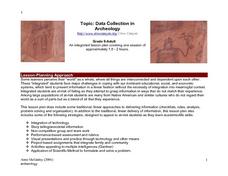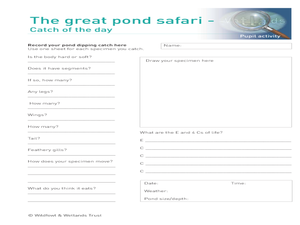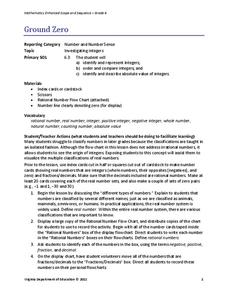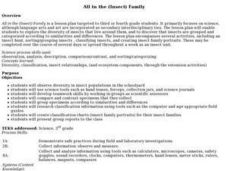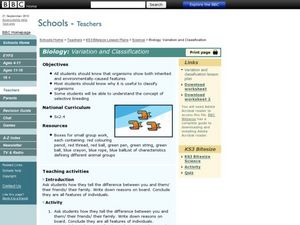Curated OER
Insulators And Conductors
High schoolers investigate the flow of electricity and how it effects different objects in the classroom as being classified as an insulator or conductor. They work in teams to test the conductivity of different classroom objects after...
Curated OER
Our Compromise, Our Constitution
Sixth graders explore, analyze and study our constitutional government and become aware of the purpose of our government. They assess the basic rights that are protected by the United States Constitution through graphic organizers and...
Curated OER
Collecting Plankton
In this science worksheet, students learn facts about plankton by reading two pages of factual information. Students read about the different kinds of plankton and how it is classified. Detailed drawings are included. There are no...
Curated OER
The Euglena
In this euglena worksheet, students read information about these unicellular organisms. Students then color in the different structures of the euglena on a diagram. Students complete 10 short answer questions.
Curated OER
Data Collection in Archaeology
Students research different types of rock art and categorize it into basic groups, classify Powerpoint Images according to interpretation, enter findings into Access template, and interpret results after comparing information with rest...
Curated OER
ChromaCool!
Fifth graders watch a video about physical and chemical changes. In groups, they participate in a variety of activities involving color. They write their observations in a journal. To end the lesson, they use a checklist to classify...
Curated OER
Sorting
Students sort class books into categories to help classify and organize them so they are easier to find. In this sorting lesson plan, students go to the library and see how they organize their books and do the same in the classroom.
Curated OER
Principal Parts of the Verb
In this verb parts worksheet, students read about present, past and past participle, then complete an organizer, writing the past and past participle of given verbs. Worksheet contains links to additional activities.
Curated OER
Saltwater Science
Students conduct an experiment that shows them how salt water allows things to float. In this salt water lesson plan, students mix ingredients together to create salt water and observe how it makes the oceans dense. They then interpret...
Curated OER
Pond Safari
Students investigate organisms and animals by examining a nearby pond. In this ecosystem lesson, students participate in a field trip to a local pond where they utilize a net to gather animals, plants and pollution items, Students...
Curated OER
Surface Area with Polydrons
Students explore measurements by analyzing geometric shapes. In this surface area lesson, students identify the terms volume, weight, perimeter and area in order to find the requested measurements of specific polygons. Students utilize...
Curated OER
Realistic Fiction
Explore the characteristics of realistic fiction by reading and then analyzing the book, Allie’s Basketball Dream by Barbara E. Barber. Using the I do, we do, you do model, learners practice identifying realistic fiction based on how...
Curated OER
Distinguishing Main and Secondary Details
Fourth graders read the passage Seven Great Summits and identify the main idea and main and secondary details. In this details lesson plan, 4th graders classify their details into 2 categories.
Virginia Department of Education
Ground Zero
Don't harbor any negative feelings toward negative numbers. Scholars learn about different classifications of rational numbers, including negative integers. They also develop definitions of the opposite and the absolute value of a...
Curated OER
What Things Move Fast and Slow?
In this fast and slow movement worksheet, students will brainstorm things that move at fast speeds and things that move at slow speeds. Students will write these items in the correct category in this graphic organizer worksheet.
Curated OER
How Does Earth's Crust Change?
In this Earth's crust worksheet, students will brainstorm changes that occur in the Earth's crust, mantle, and core. Students will complete this graphic organizer.
Curated OER
What Have Scientists Learned About Stars
In this stars worksheet, students will compare the stages in the life cycle of an average star and a massive star. This worksheet is a graphic organizer.
Curated OER
How Do Plants Carry Out Life Processes?
In this plants worksheet, students write in how a plant's leaves, roots, and stems help it to live. This worksheet is a graphic organizer.
Curated OER
Life Cycle of Trees
Turn your students into young tree-tectives with this fun science investigation into the life of trees. To begin, a class volunteer gets dressed up in a tree costume as the different parts of trees are introduced. Then, the class learns...
Curated OER
All in the (Insect) Family
Students participate in a series of activities in order to explore the diversity of insects. They explore how insects are grouped and categorized.
Curated OER
What Kind of Insect is That?
Fifth graders characterize insects and classify insects according to the Linnaean system. They use hand lenses or microscopes to examine insect body parts.
Curated OER
Classification: Dichotomous Key
Learners explain the classification process of organisms. In this biology lesson, students practice writing the names of organisms scientifically. They answer the dichotomous key and discuss answers as a class.
Curated OER
Biology: Variation and Classification
Students investigate classification of different animal groups. In this biology instructional activity students list characteristics of themselves and others they know to show differences and how they are classified. Students then answer...
Curated OER
Pheed the World: Edible Phyla
Young scholars discuss the contributions of different organisms to our world. In this biology lesson plan, students research countries with limited food supply. They create an improvement plan for a fictitious country assigned to them.






